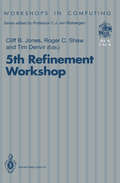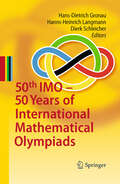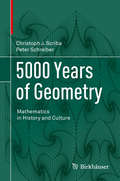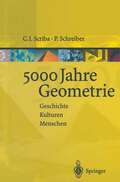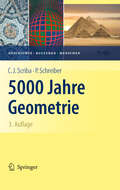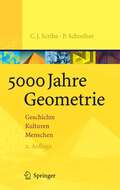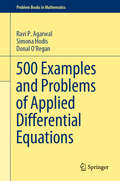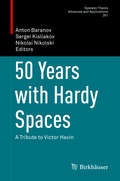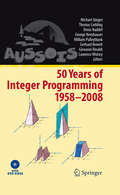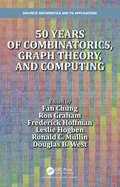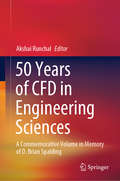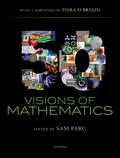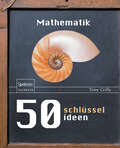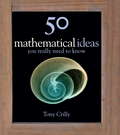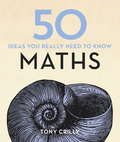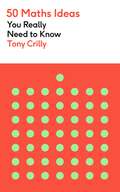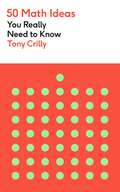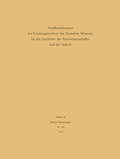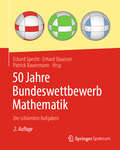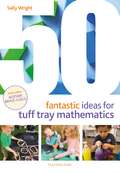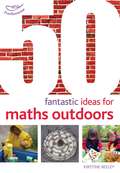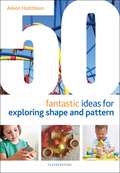- Table View
- List View
5th Refinement Workshop: Proceedings of the 5th Refinement Workshop, organised by BCS-FACS, London, 8–10 January 1992 (Workshops in Computing)
by Cliff Jones Roger C. Shaw Tim DenvirRefinement is the term used to describe systematic and formal methods of specifying hard- and software and transforming the specifications into designs and implementations. The value of formal methods in producing reliable hard- and software is widely appreciated by academics and workers in industry, despite the fact that certain research areas, such as the application to industrial-scale problems, are still in their infancy. This volume contains the papers presented at the 5th Refinement Workshop held in London, 8-10 January 1992. Its theme was the theory and practice of software specifications, which is the transformation of formal software specifications into more correct specifications, designs and codes. This has been an important area of research for the last 5 years and the workshop addressed specific issues and problems related to it. Among the topics discussed in this volume are: the role of refinement in software development, parallel designs and implementations, methods and tools for verification of critical properties, refinement and confidentiality, concurrent processes as objects, the compliance of Ada programs with Z specifications and a tactic driven refinement tool. This is the latest refinement workshop proceedings to be published in the Workshops in Computing series (the 3rd and 4th workshops having appeared in 1990 and 1991 respectively). It will be of interest to academic and industrial researchers, postgraduate students and research-oriented developers in the computer industry.
5mm grid (tactile)
by Adrian FarnsworthThis page shows a blank grid made up of five millimetre squares.
50th IMO - 50 Years of International Mathematical Olympiads
by Hans-Dietrich Gronau Hanns-Heinrich Langmann Dierk SchleicherIn July 2009 Germany hosted the 50th International Mathematical Olympiad (IMO). For the very first time the number of participating countries exceeded 100, with 104 countries from all continents. Celebrating the 50th anniversary of the IMO provides an ideal opportunity to look back over the past five decades and to review its development to become a worldwide event. This book is a report about the 50th IMO as well as the IMO history. A lot of data about all the 50 IMOs are included. We list the most successful contestants, the results of the 50 Olympiads and the 112 countries that have ever taken part. It is impressive to see that many of the world’s leading research mathematicians were among the most successful IMO participants in their youth. Six of them gave presentations at a special celebration: Bollobás, Gowers, Lovász, Smirnov, Tao and Yoccoz. This book is aimed at students in the IMO age group and all those who have interest in this worldwide leading competition for highschool students.
5000 Years of Geometry: Mathematics in History and Culture
by Christoph J. Scriba Peter SchreiberThe present volume provides a fascinating overview of geometrical ideas and perceptions from the earliest cultures to the mathematical and artistic concepts of the 20th century. It is the English translation of the 3rd edition of the well-received German book “5000 Jahre Geometrie,” in which geometry is presented as a chain of developments in cultural history and their interaction with architecture, the visual arts, philosophy, science and engineering.Geometry originated in the ancient cultures along the Indus and Nile Rivers and in Mesopotamia, experiencing its first “Golden Age” in Ancient Greece. Inspired by the Greek mathematics, a new germ of geometry blossomed in the Islamic civilizations. Through the Oriental influence on Spain, this knowledge later spread to Western Europe. Here, as part of the medieval Quadrivium, the understanding of geometry was deepened, leading to a revival during the Renaissance. Together with parallel achievements in India, China, Japan and the ancient American cultures, the European approaches formed the ideas and branches of geometry we know in the modern age: coordinate methods, analytical geometry, descriptive and projective geometry in the 17th an 18th centuries, axiom systems, geometry as a theory with multiple structures and geometry in computer sciences in the 19th and 20th centuries.Each chapter of the book starts with a table of key historical and cultural dates and ends with a summary of essential contents of geometry in the respective era. Compelling examples invite the reader to further explore the problems of geometry in ancient and modern times.The book will appeal to mathematicians interested in Geometry and to all readers with an interest in cultural history.From letters to the authors for the German language editionI hope it gets a translation, as there is no comparable work.Prof. J. Grattan-Guinness (Middlesex University London)"Five Thousand Years of Geometry" - I think it is the most handsome book I have ever seen from Springer and the inclusion of so many color plates really improves its appearance dramatically!Prof. J.W. Dauben (City University of New York)An excellent book in every respect. The authors have successfully combined the history of geometry with the general development of culture and history. …The graphic design is also excellent.Prof. Z. Nádenik (Czech Technical University in Prague)
5000 Jahre Geometrie: Geschichte Kulturen Menschen (Vom Zählstein zum Computer)
by Christoph J. Scriba Peter SchreiberLange bevor die Schrift entwickelt wurde, hat der Mensch geometrische Strukturen wahrgenommen und systematisch verwendet: ob beim Weben oder Flechten einfacher zweidimensionaler Muster oder beim Bauen mit dreidimensionalen Körpern. Das Buch liefert einen faszinierenden Überblick über die geometrischen Vorstellungen und Erkenntnisse der Menschheit von der Urgesellschaft bis hin zu den mathematischen und künstlerischen Ideen des 20. Jahrhunderts.
5000 Jahre Geometrie: Geschichte, Kulturen, Menschen (Vom Zählstein Zum Computer Ser.)
by Christoph J. Scriba Peter SchreiberLange bevor die Schrift entwickelt wurde, hat der Mensch geometrische Strukturen verwendet. Beim Weben und Flechten entstanden einfache 2-dimensionale Muster, Bauen war ohne 3-dimensionale Körper nicht denkbar. Der Band gibt einen faszinierenden Überblick über die geometrischen Vorstellungen der Menschen von der Urgesellschaft bis zu den komplexen mathematischen wie auch künstlerischen Ideen des 20. Jahrhunderts. Für die 3. Auflage wurden neueste Forschungsergebnisse über Woodhenge und andere frühe mathematische Darstellungen aufgenommen.
5000 Jahre Geometrie: Geschichte, Kulturen, Menschen (Vom Zählstein zum Computer)
by Christoph J. Scriba Peter SchreiberLange bevor die Schrift entwickelt wurde, hat der Mensch geometrische Strukturen wahrgenommen und systematisch verwendet: ob beim Weben oder Flechten einfacher zweidimensionaler Muster oder beim Bauen mit dreidimensionalen Körpern. Das Buch liefert einen faszinierenden Überblick über die geometrischen Vorstellungen und Erkenntnisse der Menschheit von der Urgesellschaft bis hin zu den mathematischen und künstlerischen Ideen des 20. Jahrhunderts.
500 Examples and Problems of Applied Differential Equations (Problem Books in Mathematics)
by Ravi P. Agarwal Donal O’Regan Simona HodisThis book highlights an unprecedented number of real-life applications of differential equations together with the underlying theory and techniques. The problems and examples presented here touch on key topics in the discipline, including first order (linear and nonlinear) differential equations, second (and higher) order differential equations, first order differential systems, the Runge–Kutta method, and nonlinear boundary value problems. Applications include growth of bacterial colonies, commodity prices, suspension bridges, spreading rumors, modeling the shape of a tsunami, planetary motion, quantum mechanics, circulation of blood in blood vessels, price-demand-supply relations, predator-prey relations, and many more.Upper undergraduate and graduate students in Mathematics, Physics and Engineering will find this volume particularly useful, both for independent study and as supplementary reading. While many problems can be solved at the undergraduate level, a number of challenging real-life applications have also been included as a way to motivate further research in this vast and fascinating field.
50 Years with Hardy Spaces: A Tribute to Victor Havin (Operator Theory: Advances and Applications #261)
by Anton Baranov Sergei Kisliakov Nikolai NikolskiWritten in honor of Victor Havin (1933–2015), this volume presents a collection of surveys and original papers on harmonic and complex analysis, function spaces and related topics, authored by internationally recognized experts in the fields. It also features an illustrated scientific biography of Victor Havin, one of the leading analysts of the second half of the 20th century and founder of the Saint Petersburg Analysis Seminar. A complete list of his publications, as well as his public speech "Mathematics as a source of certainty and uncertainty", presented at the Doctor Honoris Causa ceremony at Linköping University, are also included.
50 Years of Integer Programming 1958-2008: From the Early Years to the State-of-the-Art
by Michael Jünger Thomas M. Liebling Denis Naddef George L. Nemhauser William R. Pulleyblank Gerhard Reinelt Giovanni Rinaldi Laurence A. WolseyIn 1958, Ralph E. Gomory transformed the field of integer programming when he published a paper that described a cutting-plane algorithm for pure integer programs and announced that the method could be refined to give a finite algorithm for integer programming. In 2008, to commemorate the anniversary of this seminal paper, a special workshop celebrating fifty years of integer programming was held in Aussois, France, as part of the 12th Combinatorial Optimization Workshop.It contains reprints of key historical articles and written versions of survey lectures on six of the hottest topics in the field by distinguished members of the integer programming community. Useful for anyone in mathematics, computer science and operations research, this book exposes mathematical optimization, specifically integer programming and combinatorial optimization, to a broad audience.
50 years of Combinatorics, Graph Theory, and Computing (Discrete Mathematics and Its Applications)
by Fan Chung, Ron Graham, Frederick Hoffman, Leslie Hogben, Ronald C. Mullin and Douglas B. West50 Years of Combinatorics, Graph Theory, and Computing advances research in discrete mathematics by providing current research surveys, each written by experts in their subjects. The book also celebrates outstanding mathematics from 50 years at the Southeastern International Conference on Combinatorics, Graph Theory & Computing (SEICCGTC). The conference is noted for the dissemination and stimulation of research, while fostering collaborations among mathematical scientists at all stages of their careers. The authors of the chapters highlight open questions. The sections of the book include: Combinatorics; Graph Theory; Combinatorial Matrix Theory; Designs, Geometry, Packing and Covering. Readers will discover the breadth and depth of the presentations at the SEICCGTC, as well as current research in combinatorics, graph theory and computer science.Features: Commemorates 50 years of the Southeastern International Conference on Combinatorics, Graph Theory & Computing with research surveys Surveys highlight open questions to inspire further research Chapters are written by experts in their fields Extensive bibliographies are provided at the end of each chapter
50 years of Combinatorics, Graph Theory, and Computing (Discrete Mathematics and Its Applications)
by Ronald C. Mullin Leslie Hogben Douglas B. West Fan Chung Ron Graham Frederick Hoffman50 Years of Combinatorics, Graph Theory, and Computing advances research in discrete mathematics by providing current research surveys, each written by experts in their subjects. The book also celebrates outstanding mathematics from 50 years at the Southeastern International Conference on Combinatorics, Graph Theory & Computing (SEICCGTC). The conference is noted for the dissemination and stimulation of research, while fostering collaborations among mathematical scientists at all stages of their careers. The authors of the chapters highlight open questions. The sections of the book include: Combinatorics; Graph Theory; Combinatorial Matrix Theory; Designs, Geometry, Packing and Covering. Readers will discover the breadth and depth of the presentations at the SEICCGTC, as well as current research in combinatorics, graph theory and computer science.Features: Commemorates 50 years of the Southeastern International Conference on Combinatorics, Graph Theory & Computing with research surveys Surveys highlight open questions to inspire further research Chapters are written by experts in their fields Extensive bibliographies are provided at the end of each chapter
50 Years of CFD in Engineering Sciences: A Commemorative Volume in Memory of D. Brian Spalding
by Akshai RunchalProf. D. Brian Spalding, working with a small group of students and colleagues at Imperial College, London in the mid-to late-1960’s, single-handedly pioneered the use of Computational Fluid Dynamics (CFD) for engineering practice.This book brings together advances in computational fluid dynamics in a collection of chapters authored by leading researchers, many of them students or associates of Prof. Spalding. The book intends to capture the key developments in specific fields of activity that have been transformed by application of CFD in the last 50 years. The focus is on review of the impact of CFD on these selected fields and of the novel applications that CFD has made possible. Some of the chapters trace the history of developments in a specific field and the role played by Spalding and his contributions. The volume also includes a biographical summary of Brian Spalding as a person and as a scientist, as well as tributes to Brian Spalding by those whose life was impacted by his innovations. This volume would be of special interest to researchers, practicing engineers, and graduate students in various fields, including aerospace, energy, power and propulsion, transportation, combustion, management of the environment, health and pharmaceutical sciences.
50 Visions of Mathematics
by Dara O' BriainRelax: no one understands technical mathematics without lengthy training but we all have an intuitive grasp of the ideas behind the symbols. To celebrate the 50th anniversary of the founding of the Institute of Mathematics and its Applications (IMA), this book is designed to showcase the beauty of mathematics - including images inspired by mathematical problems - together with its unreasonable effectiveness and applicability, without frying your brain. The book is a collection of 50 original essays contributed by a wide variety of authors. It contains articles by some of the best expositors of the subject (du Sautoy, Singh and Stewart for example) together with entertaining biographical pieces and articles of relevance to our everyday lives (such as Spiegelhalter on risk and Elwes on medical imaging). The topics covered are deliberately diverse and involve concepts from simple numerology to the very cutting edge of mathematics research. Each article is designed to be read in one sitting and to be accessible to a general audience. There is also other content. There are 50 pictorial 'visions of mathematics' which were supplied in response to an open call for contributions from IMA members, Plus readers and the worldwide mathematics community. You'll also find a series of "proofs " of Phythagoras's Theorem - mathematical, literary and comedy - after this, you'll never think of Pythagoras the same way again.
50 Schlüsselideen Mathematik
by Tony CrillyDieser verständlich geschriebene Führer zur Gedankenwelt der Mathematik erklärt in kompakten und klaren Essays 50 zentrale Konzepte der Disziplin. Mit anschaulichen Grafiken, zahlreichen Beispiele und unterhaltsamen Anekdoten eröffnet das Buch auch denjenigen den Zugang, die ansonsten schon bei der bloßen Erwähnung des Wortes Mathematik in Panik geraten. Zu den näher erläuterten Schlüsselideen zählen imaginäre Zahlen, goldene Rechtecke und magische Quadrate ebenso wie die Gesetze der Genetik und das Geburtstagsproblem. Indem das Werk die Wissenschaft hinter den 50 entscheidenden Einsichten erkundet – vom Einfachen (wie der Zahl 1) über das Subtile (die Erfindung der Null) bis zum Komplexen (dem Beweis des Fermat’schen Theorems) –, verdeutlicht es auch, wie die Mathematik unsere Sicht auf die Welt verändert hat. Ohne die Erkenntnisse dieser Disziplin wären wir jedenfalls nicht dort, wo wir heute stehen. Mit diesem Buch können Sie mitreden.
50 Maths Ideas You Really Need to Know (50 Ideas You Really Need to Know series)
by Tony CrillyJust the mention of mathematics is enough to strike fear into the hearts of many, yet without it, the human race couldn't be where it is today. By exploring the subject through its 50 key insights - from the simple (the number one) and the subtle (the invention of zero) to the sophisticated (proving Fermat's last theorem) - this book shows how mathematics has changed the way we look at the world around us.
50 Maths Ideas You Really Need to Know (50 Ideas You Really Need to Know series)
by Tony CrillyWho invented zero? Why 60 seconds in a minute? How big is infinity? Where do parallel lines meet? And can a butterfly's wings really cause a storm on the far side of the world? In 50 Maths Ideas You Really Need to Know, Professor Tony Crilly explains in 50 clear and concise essays the mathematical concepts - ancient and modern, theoretical and practical, everyday and esoteric - that allow us to understand and shape the world around us. Packed with diagrams, examples and anecdotes, this book is the perfect overview of this often daunting but always essential subject. For once, mathematics couldn't be simpler. Contents include: Origins of mathematics, from Egyptian fractions to Roman numerals; Pi and primes, Fibonacci numbers and the golden ratio; What calculus, statistics and algebra can actually do; The very real uses of imaginary numbers; The Big Ideas of relativity, Chaos theory, Fractals, Genetics and hyperspace; The reasoning behind Sudoku and code cracking, Lotteries and gambling, Money management and compound interest; Solving of Fermat's last theorem and the million-dollar question of the Riemann hypothesis.
50 Maths Ideas You Really Need to Know (50 Ideas You Really Need to Know series)
by Tony CrillyIn a series of 50 accessible essays, Tony Crilly explains and introduces the mathematical laws and principles -ancient and modern, theoretical and practical, everyday and esoteric - that allow us to understand the world around us.From Pascal's triangle to money management, ideas of relativity to the very real uses of imaginary numbers, 50 Maths Ideas is a complete introduction to the most important mathematical concepts in history.
50 Maths Ideas You Really Need to Know (50 Ideas You Really Need to Know series)
by Tony CrillyIn a series of 50 accessible essays, Tony Crilly explains and introduces the mathematical laws and principles-ancient and modern, theoretical and practical, everyday and esoteric-that allow us to understand the world around us.From Pascal's triangle to money management, ideas of relativity to the very real uses of imaginary numbers, 50 Math Ideas is a complete introduction to the most important mathematical concepts in history.
50 Jahre GAMM: Im Auftrag und unter Mitwirkung des Fachausschusses für die Geschichte der GAMM
by Gesellschaft für Angewandte Mathematik und Mechanik Helmuth Gericke50 Jahre Bundeswettbewerb Mathematik: Die schönsten Aufgaben
Dieses Buch wird alle Liebhaber der Mathematik (und die es werden wollen) durch eine Fülle von reizvollen und unterhaltsamen Problemstellungen aus Algebra, Geometrie, Kombinatorik und Zahlentheorie begeistern. Vierzig ausgewählte Aufgaben aus 50 Jahren Bundeswettbewerb Mathematik werden mit ausführlichen Lösungen, Einblicken in das mathematische Umfeld und inhaltlichen Variationen reich illustriert präsentiert. Von der Mathematik geht für viele seit jeher eine besondere Faszination aus. Wer tiefer in sie eindringt, entdeckt ihre Schönheit, ihre Eleganz und ihre unendliche Vielfalt und stößt immer wieder auf überraschende Resultate. Hiermit bereits bei Schülerinnen und Schülern Interesse zu wecken, ist eines der Anliegen des Bundeswettbewerbs Mathematik. Mit seinen außergewöhnlichen Aufgaben regt er seit nunmehr einem halben Jahrhundert Jugendliche an, sich intensiv mit elementarer Mathematik auf höherem Niveau zu beschäftigen und Erfahrungen im Problemlösen zu sammeln.Anhand von ausgewählten und besonders ansprechenden Problemstellungen dokumentiert dieses Buch deren Reiz und beleuchtet ihren jeweiligen mathematischen Hintergrund. Darüber hinaus sind alle Aufgaben, die seit dem ersten Lauf des Bundeswettbewerbs Mathematik im Schuljahr 1970/71 gestellt worden sind, vollständig enthalten.
50 Fantastic Ideas for Tuff Tray Mathematics (50 Fantastic Ideas)
by Sally WrightThe tuff tray is a staple resource in Early Years settings that supports many different styles of learning and play, including incorporating early mathematics through invitations to play. The tuff tray is extremely versatile and its shape and height promotes collaborative play as young children negotiate space and resources.50 Fantastic Ideas for Tuff Tray Mathematics is filled with inspiring ideas for exploring mathematical concepts such as size, shape, capacity, quantity, distance, volume and numbers using tuff trays. From exploring time with ice cubes to cutting shapes out of tortilla wraps, Sally Wright presents opportunities for mathematical learning objectives to be met in an exciting and creative way.
50 Fantastic Ideas For Maths Outdoors (PDF)
by Kirstine Beeley Alistair Bryce-CleggOutdoor learning is not just about taking what we do indoors and moving it out through the door of our setting. It involves equipment and experiences which are both unique and exciting. When planning for maths provision practitioners need to make sure they offer access to these amazing opportunities for learning and integrate them into children's ongoing play and exploration of their natural world. Designed to be used as a dip in dip out collection of easy to use ideas the author has tried to show how exciting outdoor learning can be developed on even the very smallest of budgets. As with all areas of early learning the author acknowledges the way that maths is integrated within play based exploration and linked to many other areas of learning. Offering ways to develop your existing provision as well as building new resources you will enjoy exploring all areas of early maths including number, pattern,shape and measuring.
50 Fantastic Ideas for Exploring Shape and Pattern (50 Fantastic Ideas)
by Alison Hutchison50 Fantastic Ideas for Exploring Shape and Pattern features activities and games filled with rich contexts for learning and discussion, as well as fun opportunities for consolidation and problem-solving.Alison Hutchison draws on her wealth of experience to present ideas in line with the Early Learning Goals for investigating shape and pattern in the world around us. She focuses on helping young children to make connections and develop language, knowledge and understanding of shape and pattern. Whether children build with fabric blocks to create patterns or explore symmetry while playing with natural materials, the easy-to-prepare activities in this book facilitate engaging learning opportunities for children's ideas and interests to be explored.

